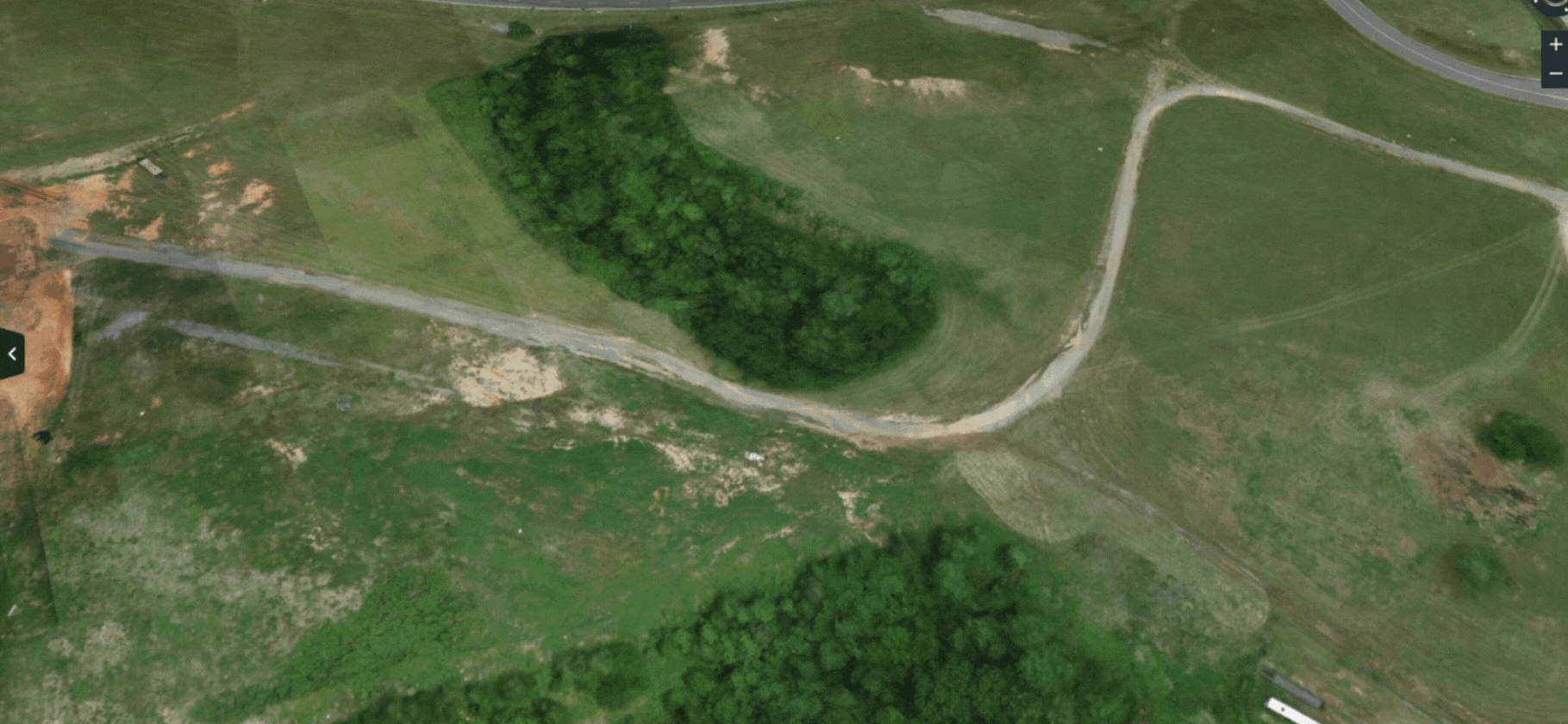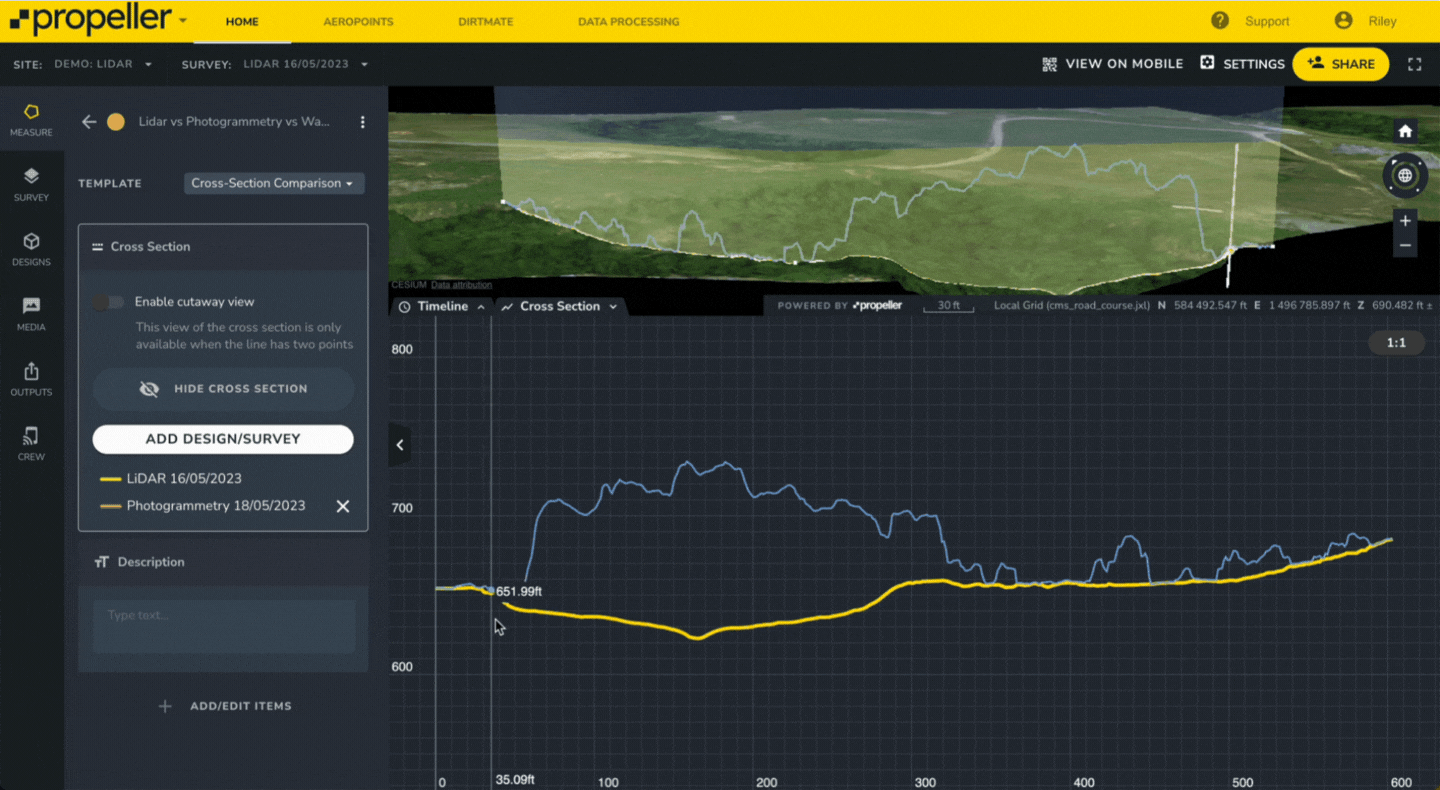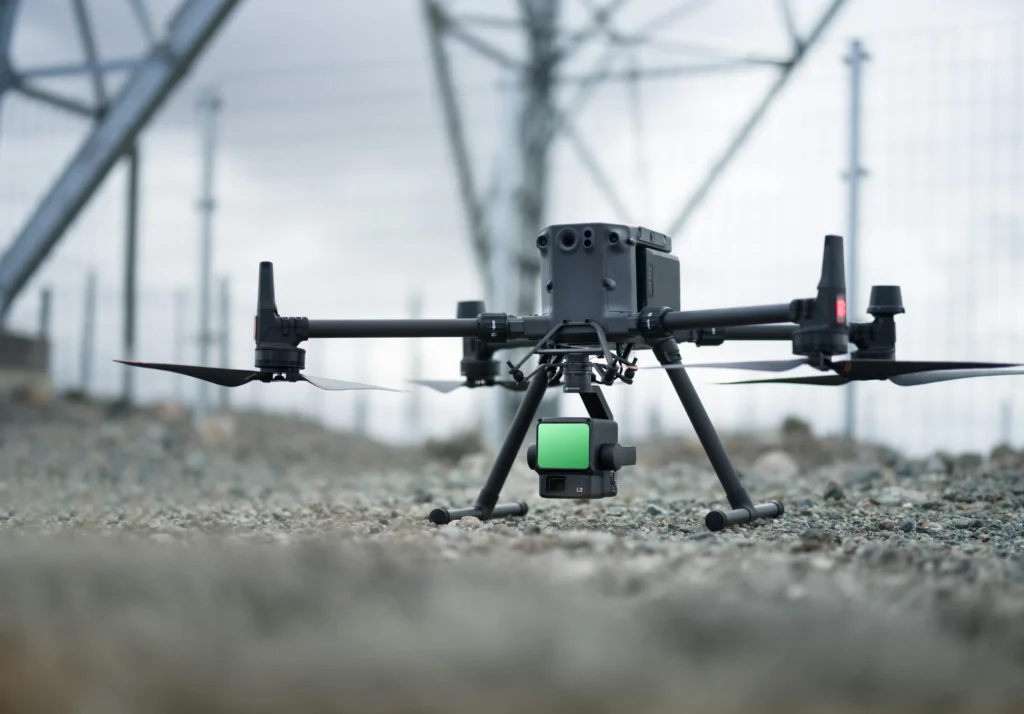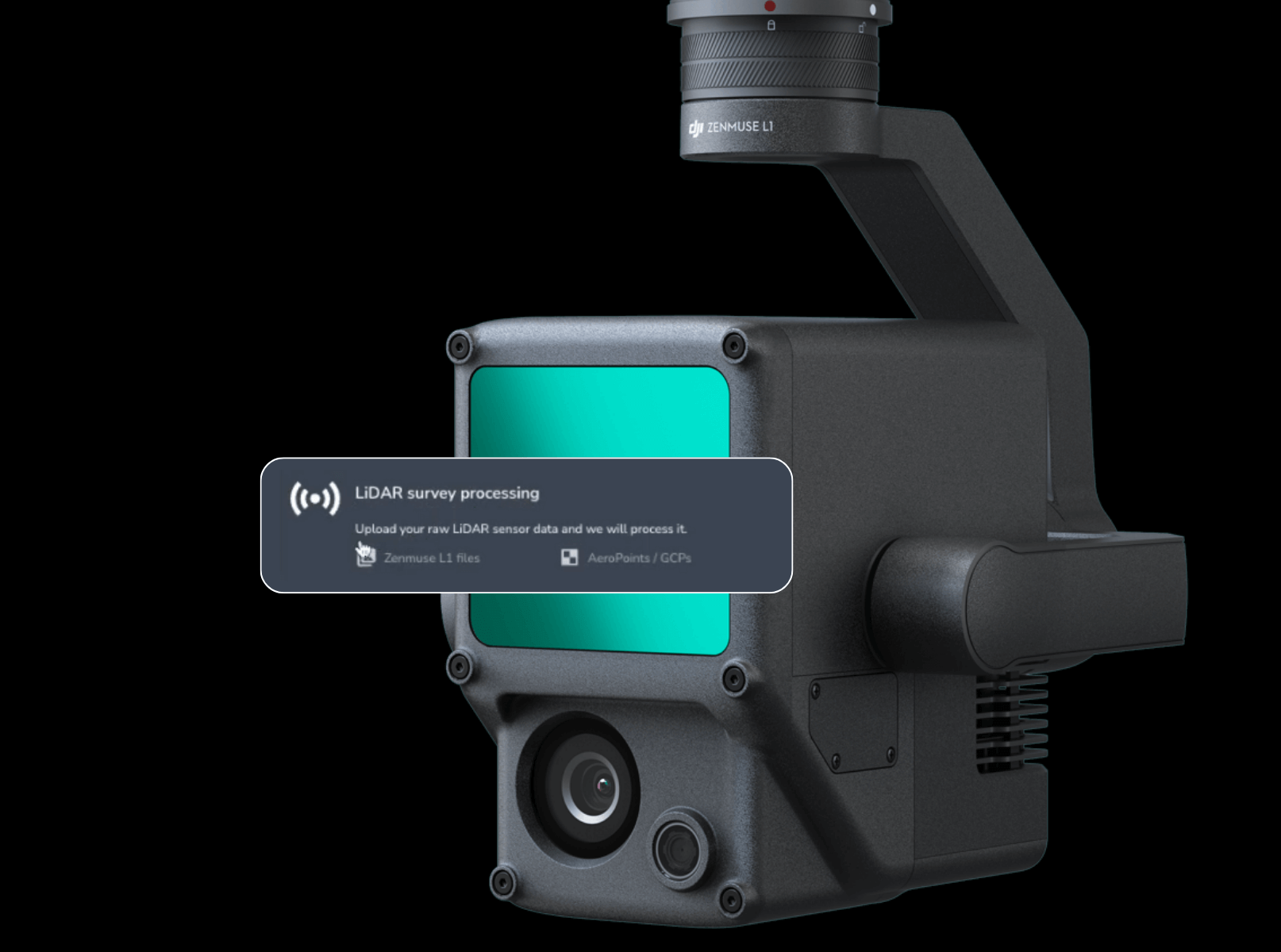Stop us if this story sounds familiar: You bid for a project on a vegetated site, only to find out after the fact that the data you used to calculate your estimate was inaccurate, outdated, or both. The result? A low bid that eats away at your margins and creates cost overruns, or a high bid that knocks you out of competition.
If that old chestnut sounds all too familiar, you’ll be just as excited about our latest feature as we are: Propeller now supports data processing for DJI’s Zenmuse L1/L2 lidar + RGB camera.
Without any further ado, let’s dive into how Propeller’s lidar data processing works—and how it can transform your pre-construction project workflows.
Laser-sharp insights: How lidar works
Before we talk about lidar, it’s helpful to revisit the basics of drone photogrammetry. Photogrammetry uses geospatial data from ground control points and aerial photos to create highly accurate 3D site maps. There’s just one catch—you can’t measure what you can’t see. Heavy vegetation on uncleared sites obscures the ground from the camera’s eye, rendering photogrammetry data far less accurate in heavily vegetated areas.
Dense vegetation is where lidar really shines. Lidar (technically an acronym for Light Detection and Ranging) uses lasers to emit tens of thousands of laser pulses per second, mapping the exact position of everything those pulses touch. Even the small spaces between leaves—imperceptible to a drone camera—can be accurately mapped with lidar. Lidar sensors scan the spaces between foliage, trees, or other flora to deliver a comprehensive view of the ground on your project or site.

An accurate view of the bare earth through vegetation (also called a Digital Terrain Model or DTM) lets you measure exactly how much earth you need to move, increasing bid accuracy and solidifying project timelines early in the process.
What makes Propeller’s lidar data processing services different?
We’ve long heard from customers who love Propeller but were forced to do drone lidar surveying separately, usually through an expensive third party, in spots where photogrammetry surveys couldn’t cut through the canopy.

Integrating lidar into your smart surveys stack creates an end-to-end experience with a long list of benefits:
- Scalability: Empower your team to complete in-house lidar surveys with one affordable sensor (the DJI Zenmuse L1 or L2).
- Managed processing: Propeller delivers lidar data processing with the speed and accuracy you trust, saving your team time, training, and infrastructure costs.
- Continuity: Our solution enables end-to-end progress tracking across lidar and photo sensors, from pre-bid all the way to project completion.
- Efficient spending: Processing with Propeller means you can use an AeroPoint for accurate and precise surveying, reducing hardware costs.
- Time savings: The DJI L1/L2 sensor attaches to your existing M300 or M350 RTK drone, letting you capture photorealistic images, geospatial data, and lidar data—all within a single flight.
In short, Propeller offers an affordable way to exponentially increase pre-bid data accuracy using the same amount of time and labor as a simple drone flight. We process your raw L1/L2 data, georeference, classify ground and non-ground points, and produce an accurate existing ground topo.
Who benefits from a bare earth model?
Any contractor dealing with vegetation on their worksites can benefit from Propeller’s drone lidar processing. We’ve seen use cases for lidar in every vertical, from residential and industrial lot development to quarry or mine expansion, road work, and landfills expanding into vegetated areas.
Propeller is proof that lidar and photogrammetry aren’t competing solutions—they’re complementary. After the bidding process is complete and your site has been cleared, you can continue using the Propeller solution for photogrammetry surveys, creating a true end-to-end solution that serves you across the project lifecycle.
DJI’s Zenmuse L1/L2 Sensor + Propeller
Propeller’s lidar data processing is beautiful in its simplicity: it works with the DJI M300 or M350 drone you already have. Just add an L1/L2 lidar sensor and you’re ready to integrate lidar into your existing Propeller workflow.
 If you’re hungry for more details, here are the highlights (and if you want to get more technical, visit the FAQs below):
If you’re hungry for more details, here are the highlights (and if you want to get more technical, visit the FAQs below):
- Propeller accepts raw lidar files from the DJI L1/L2 sensor.
- Outputs include:
- Quality-controlled georeferencing and classification of ground data, performed by our team of data specialists
- PDF processing reports showing level of accuracy
- Visualized point clouds highlighting ground vs. non-ground
- DTM produced from ground-classified points
- Standard measurement exports and basic core downloads (ex: DTM GeoTIFF)
- Lidar creates an additional dataset within your platform that works just like other survey datasets, including reports, point-and-click measurements, and comparisons over time.
- Propeller provides expert troubleshooting and support, 24/7.
L1 versus L2
So, what’s the difference between L1 and L2 sensors? The L2 has a few extra capabilities:
- Simply toggle on IMU calibration and the drone does everything from there. With the plug-and-play functionality, the L2 saves 5-10 minutes of battery life on every flight.
- The L2 can collect denser data if necessary. Through thicker canopy and vegetation cover, the L2 returns more points of the bare ground than the L1.
- The RGB sensor for the L2 is a slight upgrade from the L1. 4/3” sensor and 20.9 MP.
- There are significant improvements in the processing , resulting in better alignment between flight paths and an increase in the quality of the classified point cloud.
- With a higher return rate and upgrade IMU, you can provide a cleaner point cloud with a slight reduction in processing time.
Technical FAQs
From expert analysis and advice to efficient data processing, the most productive teams are powered by Propeller. We’re committed to making your worksite map the hub for every decision you make—a place where lidar, photogrammetry, and design come together, creating actionable synergy.
Here are the answers to some of the more technical questions you may be asking yourself about Propeller’s lidar workflow.
Does Propeller support local coordinate reference systems (CRS)?
Yes, local CRSs are supported.
What kind of hardware is needed for Propeller’s lidar workflow?
DJI’s M350 drone and Zenmuse L2 sensor. AeroPoints should also be used for a complete PPK workflow.
What files are required for the lidar upload?
Zenmuse L2 files for lidar – .CLC, .CLI, .IMU, .JPG, .LDR, .RTK, .RTL, .RTS
For Photogrammetry PPK – JPGs (images), Timestamp.MRK, .RTK
Minimum of one GCP for published sites, two for local sites
How much does lidar processing cost?
Lidar pricing is credit-based. Lidar credits must be purchased separately from processing packs.
What exports are available?
Static Download
- Rough orthophoto in the site CRS (GeoTIFF)
- Digital Terrain Model (DTM) in site CRS (GeoTIFF)
- Elevation Contours in 1 and 2 unit values (DXF)
- Point cloud in the site CRS (LAS)
- PDF Processing Report
Dynamic Download
- Rough orthophoto (GeoTIFF, JPEG, KML, JP2, PNG)
- Outline (DXF or KML)
- Surface (DXF or TTM (usually for Stratus only))
- Point cloud (LAS, LAZ, or CSV)
How are the terrains generated?
From the lidar point cloud “ground” classification.
Can I use lidar datasets to create composite surveys?
Yes, composite terrain models and/or orthophotos can include any dataset—lidar, photogrammetry, or preprocessed. However, we do not support point cloud composites.
What drones does Propeller support with the L2 sensor for lidar and photogrammetry?
We support the L2 paired with DJI’s M300/M350 drone for lidar and photogrammetry.
To use the M300 with the L2, you must upgrade the Remote Controller to RC+ (the M350 controller), which does not come with the M300 by default.
Do you have a hard limit for lidar point cloud uploads?
Yes, 1 billion points.
Do we perform trajectory alignment during lidar processing?
Yes, this is performed to ensure the most accurate point cloud and terrain data is produced.
Do lidar datasets have a processing report?
Yes, a PDF can be downloaded from the files modal.
If I turn off “unclassified points” will that be reflected in the point cloud file when downloaded?
No, it will not. All points will be included with their appropriate classes
How do terrain edits work with lidar data?
They are applied to the terrain, not the point cloud, and will work the same as other surveys
Why does my contour map extend so far beyond the survey?
Sparse points around the edge of the survey lead to this.




